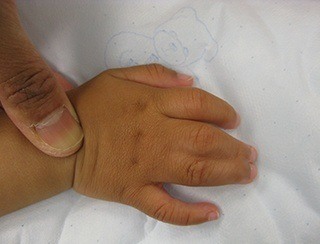Syndactyly

Syndactyly refers to persistent webbing between digits, or failure of the digits to separate during embryonic development. Syndactyly can be simple (soft tissue only, with no bone involvement) or complex (failure of the bones of the fingers to separate, as well as the soft tissues); complete (all the way out to the fingertips) or incomplete (there is some degree of separation of the fingers). The web space between the long and ring fingers is most commonly affected, but syndactyly can occur between any adjacent digits. Earlier treatment is recommended when the involved digits are of significantly different lengths, such as between the ring and small fingers. Surgical separation of the digits is usually recommended, around the age of 2, when the child is old enough to make anesthesia as safe as possible, after he/she has started walking, and yet young enough to be able to easily adapt to the new, separated state of the fingers after recovering from surgery. Depending on the extent of involvement of the syndactyly, skin grafts may be required, and this is typically taken from the groin area. Surgery is performed under general anesthesia and usually takes a few hours. It is still outpatient surgery, so you would be able to take your child home after the surgery. A cast is applied from above the elbow to the tips of the fingers (you usually cannot see the fingers) to protect the surgery. This remains in place for about 3 weeks. If your child has webbed fingers, Dr. Yu will discuss all aspects of surgery and recovery with you.




